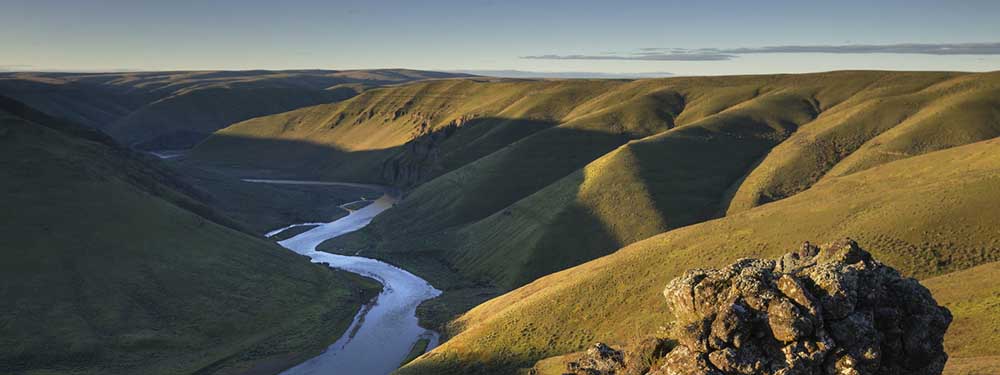Group formed to invest, grant money from state’s largest environmental damages settlement
Published 6:31 am Friday, May 30, 2025

- John Day River from above the Columbia Plateau.
The Oregon Environmental Restoration Council will help invest and dole out nearly $700 million in funds the state received from a settlement with Monsanto
More than two years ago, Oregon settled with agrochemical giant Monsanto over the company’s alleged role in polluting waters of the state for more than 90 years with toxic chemicals harming humans and aquatic species.
Now, Gov. Tina Kotek and the newly established Oregon Environmental Restoration Council will begin planning, investing and distributing that settlement money – $698 million – over the course of 50 years, using it to pay for environmental restoration and cleanup work across the state. Kotek announced the council’s chairs Wednesday, as well as details about how the money in the state’s Environmental Restoration Fund will eventually be allocated.
“The term ‘once-in-a-generation opportunity’ can be a little bit hyperbolic, but I think in this case, it’s absolutely true,” said Nicole Maness, manager of the fund. “This is a significant amount of money, and it’s coming at a time when there’s a huge amount of uncertainty around federal funding for restoration.”
The settlement money will be invested by the State Treasury, and earn interest income that will be distributed by the Environmental Restoration Council and the Oregon Watershed Enhancement Board biennially, Maness said.
Half of the settlement money awarded each biennium will go to state agencies to support work on water and environmental restoration. One quarter will go to the nine federally recognized tribes in Oregon for conservation and natural resources; and the remaining quarter will go to local communities and community-based organizations for projects benefitting people and neighborhoods disproportionately harmed by pollution.
The settlement
The deal between the Oregon Department of Justice and Monsanto is the largest environmental damages settlement in state history. The company agreed to pay in December 2022 to end a lawsuit brought by then Oregon Attorney General Ellen Rosenblum over allegations that Monsanto had for decades polluted state waters with Polychlorinated biphenyls, also called PCBs. Oregon is among several states that have sued the company, which has not admitted guilt or liability for the pollution.
Monsanto was for decades the only manufacturer, seller and distributor of PCBs — colorless or light yellow compounds once used in coolants, electrical equipment, hydraulic oils, paints and caulking and copy paper — until it voluntarily ceased production of the compounds in 1977. The Centers for Disease Control and Prevention has found the compounds can cause cancer in animals, and the federal Environmental Protection Agency says they are likely human carcinogens. PCBs continue to leach from landfills and travel into ground and surface waters where they are difficult to remove.
More than a dozen waterways in Oregon are damaged by PCBs, including the Portland Harbor, Lower Columbia River, Middle Columbia River, Willamette River, Upper and Lower John Day Rivers and Coos Bay.
The money will be used for more than just trying to tackle PCB pollution, Maness said, and “in a way that is going to be meaningful to Oregonians, that is going to strike that balance between addressing past harms, but also opportunities to restore places that are important to people, important to wildlife.”
These could include removing barriers to fish passage, improving overall water quality and aquatic habitat and ensuring salmon consumed among many tribes in Oregon are abundant and safe to eat, she said.
The council
Kotek on Wednesday announced she appointed Chuck Sams, an enrolled member of the Confederated Tribes of the Umatilla Indian Reservation and the former director of the National Park Service, and Michael Dembrow, former Democratic state senator representing Portland, as co-chairs of the council. She also appointed Vice Chair Cheyenne Holliday, advocacy director at the nonprofit Portland-based environmental and social justice group Verde.
“This is a tremendous opportunity for us to improve the health and living conditions of Oregonians in every part of the state, year after year for the next fifty years at least,” Dembrow said in a news release. “It’s especially important to have this stable source of funding right now, given our uncertain state budget and little hope for federal support for this important work.”
The rest of the council will be made up of the directors, or a designee of the directors, of the Oregon Health Authority, Oregon Department of Fish and Wildlife and the Oregon Department of Environmental Quality; Oregon’s attorney general or someone from the Office of the Attorney General; and two non-voting members from the Oregon House of Representatives and the Oregon Senate, chosen by those chambers.
Kotek has yet to pick the final two members of the 11-member council she gets to appoint, but Maness said they will have to possess expertise in either PCBs or a wide range of environmental toxins.
The council aims to have its first meeting this summer, Maness said.









